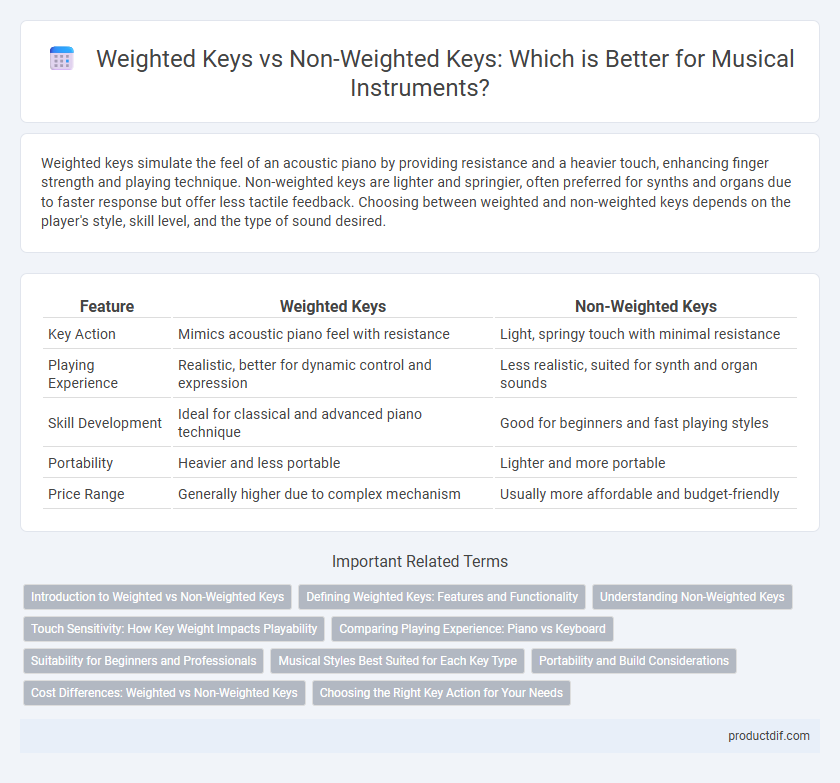Weighted keys simulate the feel of an acoustic piano by providing resistance and a heavier touch, enhancing finger strength and playing technique. Non-weighted keys are lighter and springier, often preferred for synths and organs due to faster response but offer less tactile feedback. Choosing between weighted and non-weighted keys depends on the player's style, skill level, and the type of sound desired.
Table of Comparison
| Feature | Weighted Keys | Non-Weighted Keys |
|---|---|---|
| Key Action | Mimics acoustic piano feel with resistance | Light, springy touch with minimal resistance |
| Playing Experience | Realistic, better for dynamic control and expression | Less realistic, suited for synth and organ sounds |
| Skill Development | Ideal for classical and advanced piano technique | Good for beginners and fast playing styles |
| Portability | Heavier and less portable | Lighter and more portable |
| Price Range | Generally higher due to complex mechanism | Usually more affordable and budget-friendly |
Introduction to Weighted vs Non-Weighted Keys
Weighted keys simulate the tactile responsiveness and resistance of traditional piano keys, offering a more authentic playing experience for pianists. Non-weighted keys are lighter and springier, typically found on synthesizers and beginner keyboards, providing faster action but less resistance. Choosing between weighted and non-weighted keys depends on the player's skill level and desired touch sensitivity in musical expression.
Defining Weighted Keys: Features and Functionality
Weighted keys mimic the feel of acoustic piano keys by incorporating graded resistance and hammer action mechanisms that simulate the natural touch and response of traditional pianos. This design enhances finger strength and playing technique, providing dynamic control over volume and expression. Non-weighted keys lack these features, offering a lighter, more synthesizer-like action unsuitable for developing authentic piano skills.
Understanding Non-Weighted Keys
Non-weighted keys on musical keyboards are lighter and easier to press, making them ideal for beginners and digital music production. They lack the weighted mechanism found in acoustic pianos, resulting in less resistance and faster key action. Non-weighted keys provide increased speed and agility but may not develop finger strength or playing technique as effectively as weighted keys.
Touch Sensitivity: How Key Weight Impacts Playability
Weighted keys replicate the resistance found in acoustic pianos, enhancing touch sensitivity and allowing for expressive dynamics during play. Non-weighted keys offer less resistance, making them easier for beginners but limiting control over nuances in tone and volume. Key weight directly influences finger strength development and dynamic expression, crucial for advanced pianists seeking greater playability and musicality.
Comparing Playing Experience: Piano vs Keyboard
Weighted keys on pianos mimic the resistance and tactile feedback of acoustic hammers, enhancing finger strength and dynamic control for expressive plays. Non-weighted keys on keyboards tend to be lighter and faster, allowing for quicker note repetition but often lack the nuanced touch sensitivity of weighted keys. Players accustomed to weighted keys find a more authentic piano experience, while non-weighted keys offer versatility and ease for electronic music styles.
Suitability for Beginners and Professionals
Weighted keys on digital pianos closely mimic the feel of acoustic piano keys, making them ideal for beginners aiming to develop proper finger strength and technique. Non-weighted keys, often found on synthesizers and MIDI controllers, offer a lighter touch that suits professionals needing fast, expressive playing for electronic or studio work. Beginners benefit from weighted keys for foundational skills, while professionals choose key type based on stylistic requirements and performance context.
Musical Styles Best Suited for Each Key Type
Weighted keys are ideal for classical, jazz, and orchestral styles where expressive dynamics and realistic piano feel are essential, enhancing techniques like legato and staccato. Non-weighted keys suit electronic, pop, and synth-based music, offering fast action and ease for rapid note repetition and complex layering. Choosing between weighted and non-weighted keys depends on the desired musical genre and playing technique preferences.
Portability and Build Considerations
Weighted keys emulate the feel of an acoustic piano by incorporating heavier key mechanisms, often resulting in a bulkier and heavier keyboard that can be less portable for musicians on the move. Non-weighted keys feature lighter, spring-loaded actions allowing for slimmer, lighter designs that enhance portability and ease of transport. When choosing between the two, musicians should consider the balance between authentic tactile response and the convenience of carrying a more compact instrument.
Cost Differences: Weighted vs Non-Weighted Keys
Weighted keys generally cost more than non-weighted keys due to the complex mechanism that mimics the feel of an acoustic piano, adding to manufacturing expenses. Non-weighted keys, typically found on entry-level keyboards and synthesizers, are less expensive because they lack the intricate hammer-action system. Musicians seeking an authentic piano experience often invest more in weighted key instruments to achieve realistic touch sensitivity despite the higher price.
Choosing the Right Key Action for Your Needs
Weighted keys replicate the resistance and feel of acoustic piano keys, making them ideal for pianists seeking realistic touch and dynamic control in their playing. Non-weighted keys offer a lighter, more responsive action favored by beginners or players focusing on synths and fast passages. Selecting key action depends on your musical goals, with weighted keys supporting classical techniques and non-weighted keys enhancing electronic and modern styles.
Weighted Keys vs Non-Weighted Keys Infographic

 productdif.com
productdif.com